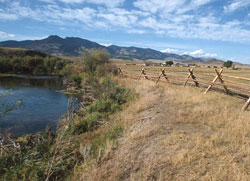Timing, intensity and frequency: What do those terms mean and how, exactly, do you manage them? University of California-Davis researchers surveyed 300 successful ranchers as part of a SARE grant to learn real-world riparian management specifics.

Here’s a list of the specific management techniques those producers use to take care of their riparian areas without sacrificing their uplands.
Reduce stock density. Smaller herds reduce potential damage to both grasses and shrubs and through less hoof action. Fewer cattle in a riparian pasture combined with grazing less frequently and rest between grazing periods adds a synergistic effect.
Reduce grazing frequency. Frequency refers to the number of times a particular plant is bitten. The most effective way to reduce frequency is to shorten grazing periods in a pasture. Strive to create a larger number of smaller pastures or use other techniques (see below) to shorten grazing periods and ensure adequate rest for the plants.
Increase rest between grazing periods. During the growing season, perennial plants need a chance to recharge leaf area and root reserves. Perennial grasses need to set seed at least once every three years to maintain healthy vigor. Managers can allow this by incorporating rest into different times of the growing season.
Herd livestock away from riparian areas. Even with a lower stocking density, livestock will congregate at the preferred areas – usually the shady, cool areas on hot days. One steer on a creek bank for 100 days will do much more damage than 100 steers on the same creek bank for one day. Moving cattle away from the preferred areas will improve grazing distribution across the whole pasture.
Provide off-site attractants. Feed salt, mineral or other supplements in under-used areas of the pasture. Move the supplements when the livestock have grazed the area enough. Off-site water will bring cattle out of riparian areas, too, even if it is as close as 100 yards from a stream.
